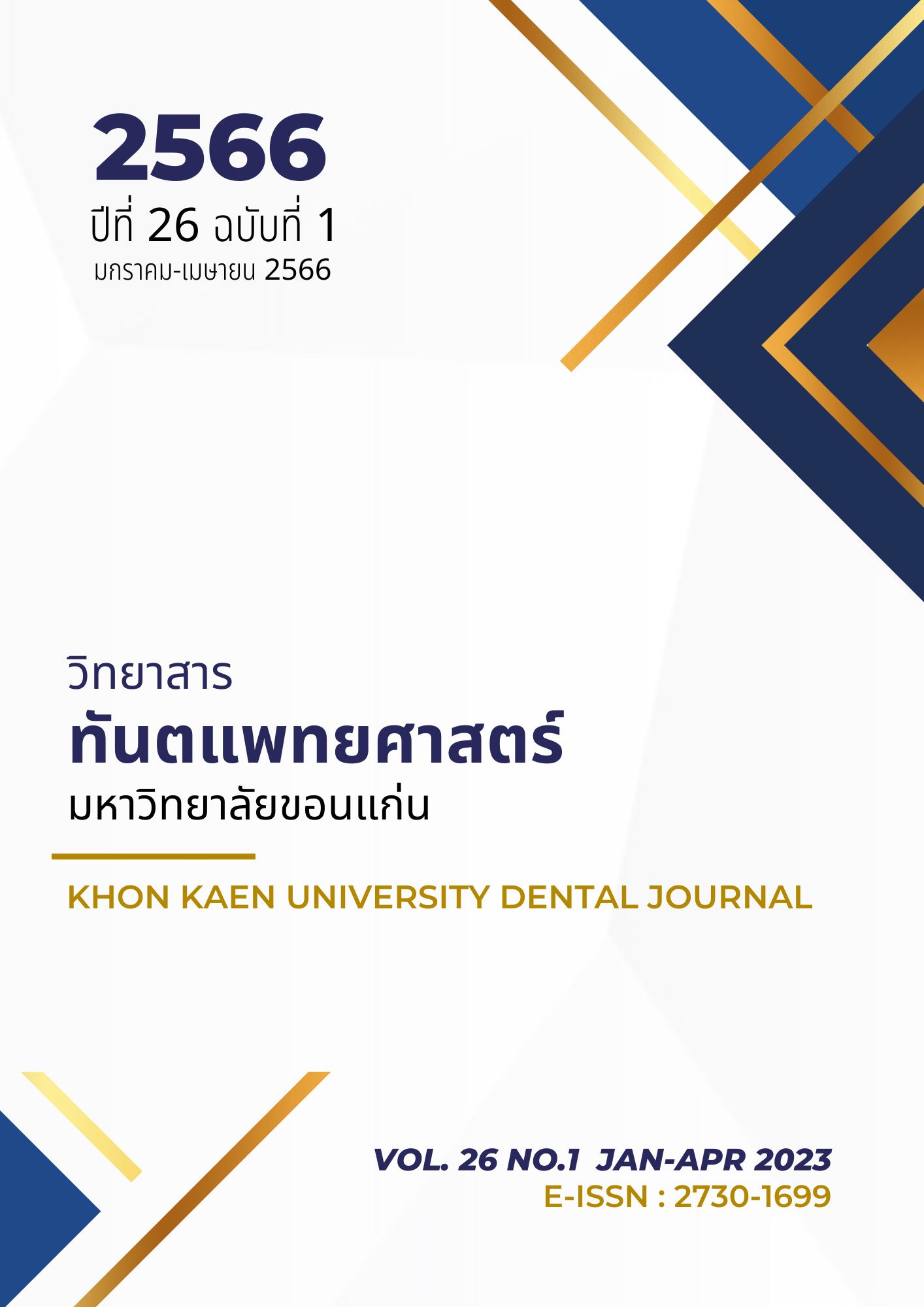การประเมินทางคลินิกของเรซินมอดิฟายด์กลาส ไอโอโนเมอร์ที่พัฒนาขึ้นในประเทศต่อการใช้เป็นวัสดุรองพื้นในการบูรณะฟันด้วยเรซินคอมโพสิต
Main Article Content
บทคัดย่อ
วัตถุประสงค์เพื่อประเมินวัสดุรองพื้นที่บ่มตัวด้วยการฉายแสงแบบเรซินมอดิฟายด์กลาสไอโอโนเมอร์ซีเมนต์ (เอ็มเบส) ที่วิจัยและพัฒนาโดยหน่วยปฏิบัติการวิจัยสมุนไพรชีววัสดุและวัสดุเพื่อการรักษาทางทันตกรรม จุฬาลงกรณ์มหาวิทยาลัย เปรียบเทียบกับเรซินมอดิฟายด์กลาสไอโอโนเมอร์ซีเมนต์ที่นำเข้าจากต่างประเทศ (วิทรีบอนด์) โดยทำการศึกษาในการบูรณะฟันที่มีชีวิตของอาสาสมัครจำนวน 20 คนที่มีอายุระหว่าง 19-62 ปี เข้ารับการตรวจทางคลินิกและภาพถ่ายรังสีรอบปลายรากก่อนทำการบูรณะฟันผุคลาสวันจำนวน 12 ซี่ หรือคลาสทูจำนวน 8 ซี่ ที่มีความลึกของรอยผุจากรอยต่อระหว่างเคลือบฟันและเนื้อฟัน (DEJ) มากกว่า 1.5 มิลลิเมตร โดยที่ยังไม่ถึงโพรงฟัน ภายหลังกำจัดรอยผุภายใต้แผ่นยางกันน้ำลายทำการสุ่ม อำพรางกับวัสดุทั้งสองชนิดเพื่อทำการรองพื้นเนื้อฟันด้านประชิดเนื้อเยื่อในด้วยวัสดุทั้งสองแต่ละชนิดให้กับอาสาสมัครกลุ่มละ 10 คน จากนั้นบูรณะฟันด้วยเรซินคอมโพสิต ทำการติดตามผลการรักษาภายหลังการบูรณะ 1 วัน และ 7 วัน โดยสอบถามอาการของอาสาสมัครทางโทรศัพท์ พร้อมทั้งนัดกลับมาติดตามผลการรักษาภายหลังการบูรณะ 3 เดือน และ 6 เดือน ตามลำดับ โดยสอบถามอาการปวด ทำการตรวจทางคลินิกโดยการเคาะคลำ และถ่ายภาพรังสีรอบปลายรากเปรียบเทียบกับก่อนการรักษา ผลของการศึกษาพบว่าเอ็มเบส ซึ่งเป็นวัสดุรองพื้นที่บ่มตัวด้วยการฉายแสงแบบเรซินมอดิฟายด์กลาสไอโอโนเมอร์ซีเมนต์ให้ผลของการรักษาทั้งอาการบอกเล่า อาการตรวจพบ และภาพรังสีของอาสาสมัครทุกช่วงเวลาของการติดตามผลไม่แตกต่างจากวิทรีบอนด์อย่างมีนัยสำคัญ (p>0.05) จากผลการศึกษานี้สรุปได้ว่า วัสดุรองพื้นเอ็มเบสสามารถเป็นวัสดุทางเลือกที่นำมาใช้ทางคลินิกได้โดยให้ผลของการรักษาไม่แตกต่างจากการใช้วัสดุรองพื้นนำเข้าจากต่างประเทศที่นำมาเปรียบเทียบ
Article Details

อนุญาตภายใต้เงื่อนไข Creative Commons Attribution-NonCommercial-NoDerivatives 4.0 International License.
บทความ ข้อมูล เนื้อหา รูปภาพ ฯลฯ ทีได้รับการลงตีพิมพ์ในวิทยาสารทันตแพทยศาสตร์ มหาวิทยาลัยขอนแก่นถือเป็นลิขสิทธิ์เฉพาะของคณะทันตแพทยศาสตร์ มหาวิทยาลัยขอนแก่น หากบุคคลหรือหน่วยงานใดต้องการนำทั้งหมดหรือส่วนหนึ่งส่วนใดไปเผยแพร่ต่อหรือเพื่อกระทำการใด ๆ จะต้องได้รับอนุญาตเป็นลายลักษณ์อักษร จากคณะทันตแพทยศาสตร์ มหาวิทยาลัยขอนแก่นก่อนเท่านั้น
เอกสารอ้างอิง
Bicalho AA, Pereira RD, Zanatta RF, Franco SD, Tantbirojn D, Versluis A, et al. Incremental filling technique and composite material. Part I: cuspal deformation, bond strength, and physical properties. Oper Dent 2014;39(2):E71-82.
Bicalho AA, Pereira RD, Zanatta RF, Franco SD, Tantbirojn D, Versluis A, et al. Incremental filling technique and composite material. Part II: shrinkage and shrinkage stress. Oper Dent 2014;39(2):E83-92.
Soares CJ, Faria-e-Silva AL, Rodrigues MP, Vilela ABF, Pfeifer CS, Tantbirojn D, et al. Polymerization shrinkage of composite resins and resin cements-what do we need to know? Braz Oral Res 2017;31(suppl):e62.
Kasraei S, Azarsina M, Majidi S. In Vitro comparison of microleakage of posterior resin composites with and without liner using two-step etch-and-rinse and self-etch dentin adhesive systems. Oper Dent 2011;36(2):213-21.
Karaman E, Ozgunaltay G. Polymerization shrinkage of different types of composite resins and microleakage with and without liner in class II cavities. Oper Dent 2014;39(3):325-31.
Sampaio PC, de Almeida Junior AA, Francisconi LF, Casas-Apayco LC, Pereira JC, Wang L, et al. Effect of conventional and resin-modified glass-ionomer liner on dentin adhesive interface of class I cavity walls after thermocycling. Oper Dent 2011;36(4):403-12.
Charoenkit M, Pumpaluk P. A micro-computed tomography study of internal gap with and without resin-modified glass-ionomer cement liner under occlusal resin composite restoration. M Dent J 2020;40(2): 159-64.
Azevedo LM, Casas-apayco LC, Villavicencio Espinoza CA, Wang L, Navarro MFL, et al. Effect of resin-modified glass-ionomer cement lining and composite layering technique on the adhesive interface of lateral wall. J Appl Oral Sci 2015;23(3):315-20.
Akpata ES, Sadiq W. Post operative sensitivity in glass ionomer versus adhesive resin-lined posterior composite. Am J Dent 2001;14(1):34-8.
Christensen GJ. Preventing postoperative sensitivity in class I, II and V restorations. J Am Dent Assoc 2002;133(2):229-31.
Schenkel AB, Veitz AK. Dental cavity liners for class I and class II resin-based composite restorations. Cochrane Database Syst Rev 2019;3(3):CD010526.doi:10.1002/14651858.DC010526. pub3.PMID:30834516.
Banomyong D, Harnirattisai C, Burrow MF. Posterior resin composite restorations with or without resin-modified glass ionomer cement lining: a 1-year randomized clinical trial. J Investig Clin Dent 2011;2(1):63-9.
Banomyong D, Harold Messer. Two-year clinical study on postoperative pulpal complications arising from the absence of a glass-ionomer lining in deep occlusal resin composite restorations. J Investig Clin Dent 2013;4(4):265-70.
Vural UK, Gokalp S, Kiremitci. Effect of cavity lining on the restoration of root surface carious lesions: a split-mouth, 5-year randomized controlled clinical trial. Clin Oral Investig 2020;24(2):979-89.
Schenkel AB, Peltz ID, Keenan AV. Dental cavity liners for Class I and Class II resin-based composite restorations. Cochrane Database Syst Rev 2016;(10): CD010526.
Banerjee A, Frencken JE, Schwendicke F, Innes NPT. Contemporary operative caries management: consensus recommendations on minimally invasive caries removal. Br Dent J 2017;223(3):215-22.
Duque C, Negrini TD, Sacono NT, Spolidorio DMP, Costa CAD, Herbling J. Clinical and microbiological performance of resin-modified glass ionomer liners after incomplete dentine caries removal. Clin Oral Invest 2009;13:465-71.
Lynch CD, Mcconnell RJ, Wilson NHF. Posterior composites: The future for restoring posterior teeth? Prim Dent 2014;3:49-53.
Blum IR, Wilson NHF. An end to linings under posterior composites? J Am Dent Assoc 2018; 149(3):209-13.
Blum IR, Wilson NHF. Consequences of no more linings under composite restorations. Br Dent J 2019;226(10):749-52.
Righolt AJ, Jevdjevic M, Marcenes W, Listl S. Global-, regional-, and country-level economic impacts of dental diseases in 2015. J Dent Res 2018;97(5):501-7.
Medical devices intelligence unit [homepage on the internet]. Available from: http://medicaldevices. oie.go.th/ImEx_ProductType.asp.
อัตราแลกเปลี่ยนเฉลี่ยของธนาคารพาณิชย์ในกรุงเทพ มหานคร: ธนาคารแห่งประเทศไทย. Available from: https://www.bot.or.th>App>statistics)
International Organization for Standardization. ISO 9917-2. Dentistry water-based cements part 2 resin-modified cements. 1988.
International Organization for Standardization. ISO 9917-2. Dentistry water-based cements part 2 resin-modified cements. 2010.
Thunyakitpisal P, Jiemsirilers S, Saravari O, Kashima DP, Thunyakitpisal N, Srisuwan P, et al. Working time, depth of curve, flexural strength and cytotoxicity of an exponential resin modified glass ionomer cement prototype. J Dent Assoc Thai 2015;65(3):189-98.
Banlunara W, Songsiripadapboon S, Jiemsirilers S, Saravari O, Kashima DP, Thunyakitpisal N, et al. Pulp-dentine complex response to RU-HBM1, a novel resin modified glass ionomer cement prototype, in deep cavity preparation of porcine teeth. Thai J Vet Med 2016;46(2):185-93.
Kenneth S, Douglas A, David M. Consort 2010 statement: Updated guidelines for reporting parallel group randomized trials. BMC Medicine 2010;8:18.
Berkowitz GS, Horowitz AJ, Curro FA, Craig RG, Ship JA, Vena D, et al. Postoperative hypersensitivity in class I resin-based composite restorations in general practice: Interim results. Compend Contin Educ Dent 2009;30(6):356-63.
Baratieri LN, Ritter AV. Four-year clinical evaluation of posterior resin-based composite restorations placed using the total-etch technique. J Esthet Restor Dent 2001;13(1)50-7.
Endodontic Diagnosis. Endodontics: Colleagues for Excellence Fall 2013. Available from: www. aae.org/colleagues.
Duncan HF, Nagendrababu V, EI-Karim IA, Dummer PMH. Outcome measures to access the effectiveness of endodontic treatment for pulpitis and apical periodontitis for use in the development of European Society of Endodontology (ESE) S3 level clinical practice guidelines: a protocol. Int Endod J 2021;54(5):646-54.
Carvalho TS, Lussi. Age-related morphological, histological and functional changes in teeth. J Oral Rehabil 2017;44(4):291-8.
Nicholson JW, Czarnecka B. The biocompatibility of resin-modified glass-ionomer cements for dentistry. Dent Mater 2008;24(12):1702-8.
Sidhu SK, Nicholson JW. A review of glass-ionomer cements for clinical dentistry. J Funct Biomater 2016;7(3):16. Available from: https://doi.org/ 10.3390/jfb7030016.
Liang C, Byoung IS. Cytotoxicity and biocompatibility of resin-free and resin-modified direct pulp capping materials: A state-of-the-art review. Dent Mater J 2017;36(1):1-7.
Dursun E, Nguyen JF, Tang ML, Attal JP, Sadoun M. HEMA release and degree of conversion from a resin-modified glass ionomer cement after various delays of light activation. Dent Mat 2016;32(5):640-5.


